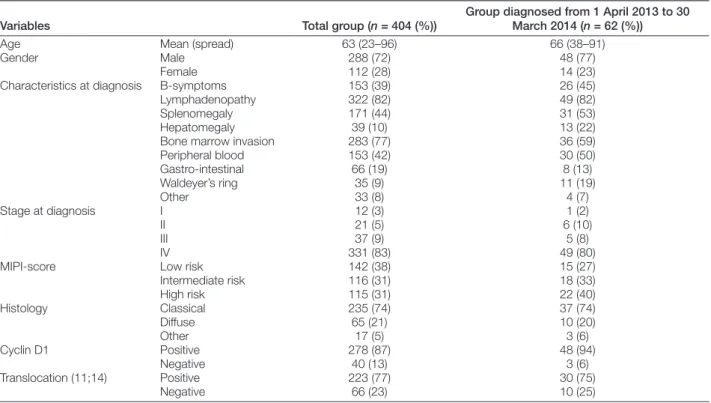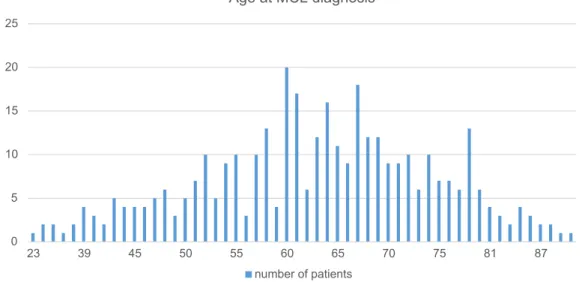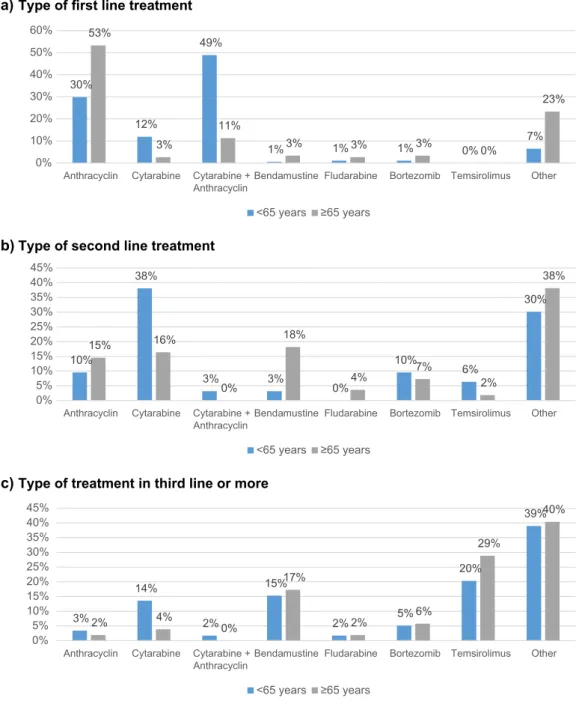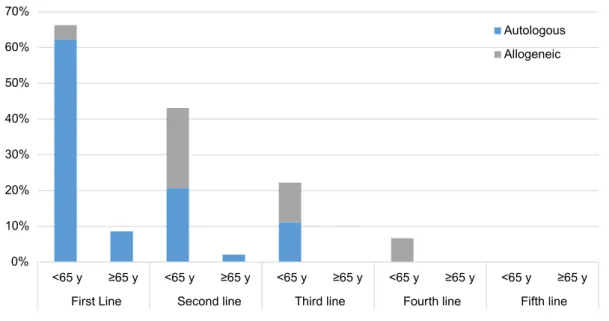Full Terms & Conditions of access and use can be found at
http://www.tandfonline.com/action/journalInformation?journalCode=yacb20
Download by: [University of Liege] Date: 04 April 2017, At: 05:13
Acta Clinica Belgica
International Journal of Clinical and Laboratory Medicine
ISSN: 1784-3286 (Print) 2295-3337 (Online) Journal homepage: http://www.tandfonline.com/loi/yacb20
Results from the Belgian mantle cell lymphoma
registry
Vibeke Vergote, Ann Janssens, Marc André, Christophe Bonnet, Vanessa Van
Hende, Eric Van Den Neste, Koen Van Eygen, Marie Maerevoet, Delphine
Pranger, Wilfried Schroyens, Sarah Debussche, Vincent Maertens, Karolien
Beel, Jan Lemmens, Charlotte Caron, Vanessa Delrieu, Isabelle Van Den
Broeck, Gaetan Vanstraelen, Caroline Jacquy, Liesbeth Schauvlieghe, Hade
De Samblanx, Vincent Madoe, Stef Meers, Dominique Boulet, Gregor
Verhoef & Achiel Van Hoof
To cite this article: Vibeke Vergote, Ann Janssens, Marc André, Christophe Bonnet, Vanessa Van Hende, Eric Van Den Neste, Koen Van Eygen, Marie Maerevoet, Delphine Pranger, Wilfried Schroyens, Sarah Debussche, Vincent Maertens, Karolien Beel, Jan Lemmens, Charlotte Caron, Vanessa Delrieu, Isabelle Van Den Broeck, Gaetan Vanstraelen, Caroline Jacquy, Liesbeth Schauvlieghe, Hade De Samblanx, Vincent Madoe, Stef Meers, Dominique Boulet, Gregor Verhoef & Achiel Van Hoof (2017): Results from the Belgian mantle cell lymphoma registry, Acta Clinica Belgica, DOI: 10.1080/17843286.2017.1293328
To link to this article: http://dx.doi.org/10.1080/17843286.2017.1293328
Published online: 22 Feb 2017. Submit your article to this journal
Article views: 38 View related articles
Results from the Belgian mantle cell
lymphoma registry
Vibeke Vergote
1, Ann Janssens
1, Marc André
2, Christophe Bonnet
3,
Vanessa Van Hende
4, Eric Van Den Neste
5, Koen Van Eygen
6, Marie Maerevoet
7,
Delphine Pranger
8, Wilfried Schroyens
9, Sarah Debussche
10,
Vincent Maertens
11, Karolien Beel
12, Jan Lemmens
13, Charlotte Caron
14,
Vanessa Delrieu
15, Isabelle Van Den Broeck
16, Gaetan Vanstraelen
17,
Caroline Jacquy
18, Liesbeth Schauvlieghe
19, Hade De Samblanx
20,
Vincent Madoe
21, Stef Meers
22, Dominique Boulet
23, Gregor Verhoef
1,
Achiel Van Hoof
241Department of Hematology, UZ Leuven, Leuven, Belgium, 2Department of Hematology, CHU UCL Namur, Yvoir,
Belgium, 3Department of Hematology, CHU de Liège, Liège, Belgium, 4Department of Hematology, UZ Gent,
Gent, Belgium, 5Department of Hematology, Cliniques universitaires Saint Luc, Brussels, Belgium, 6Department
of Hematology, AZ Groeninge, Kortrijk, Belgium, 7Department of Hematology, Institut Jules Bordet, Brussels,
Belgium, 8Department of Hematology, GHdC, Charleroi, Belgium, 9Department of Hematology, UZA, Antwerpen,
Belgium, 10Department of Hematology, AZ Turnhout, Turnhout, Belgium, 11Department of hematology,
Imeldaziekenhuis, Bonheiden, Belgium, 12Department of Hematology, ZNA Middelheim, Antwerpen, Belgium, 13Department of Hematology, GZA St. Augustinus, Antwerpen, Belgium, 14Department of hematology, VUB,
Brussels, Belgium, 15Department of Hematology, Hôpital de Jolimont, La Louvière, Belgium, 16Department of
Hematology, AZ Nikolaas, Sint Niklaas, Belgium, 17Department of Hematology, CHR Verviers, Verviers, Belgium, 18Department of Hematology, CHR de la Citadelle, Liège, Belgium, 19Department of Hematology, AZ Delta,
Roeselare, Belgium, 20Department of Hematology, AZ Dimpna, Geel, Belgium, 21Department of Hematology,
LOC, Hasselt, Belgium, 22Department of Hematology, AZ KLINA, Antwerpen, Belgium, 23Department of
Hematology, CHR Mons-Hainaut, Mons, Belgium, 24Department of Hematology, AZ Sint Jan, Brugge, Belgium
Introduction: Mantle cell lymphoma is a B-cell non-Hodgkin’s lymphoma characterized by a t(11;14), resulting in overexpression of cyclin D1. Conventional chemotherapy obtains frequent (but short) remissions, leading to a poor median overall survival (OS) of 3–5 years. To obtain more information about the prevalence and current treatment of Mantle cell lymphoma (MCL) in Belgium, we collected data in a Belgian registry of MCL. Materials and methods: All Belgian MCL patients, t(11;14) and/or cyclin D1 positive, seen in hematology departments over a one-year period (April 2013–March 2014) were included. Data about patient characteristics, histology, treatment lines, and response were compiled and retrospectively analyzed.
Results: Four hundred and four patients were included with a median age at diagnosis of 64 years (range 23–96 years) and a male predominance (72%). For 2013, we calculated a prevalence of at least 36.2 per million and an incidence of at least 7.0 per million in the Belgian population. Characteristics at diagnosis involved lymphadenopathy (82%), splenomegaly (44%), B-symptoms (39%), and hepatomegaly (10%). Bone marrow invasion was present at diagnosis in 77%. Stage at diagnosis was advanced in the majority of cases. The median number of treatment lines was 1. Type of first line treatment included a combination of anthracyclin and cytarabine-based regimen (34%), anthracyclin (39%), and other. Rituximab was used in 88% of first line treatments. In 44% first line treatment was followed by autologous stem cell transplantation.
Conclusion: The analysis of this Belgian MCL registry provides insight in the epidemiology, demographics, and current treatment of our Belgian MCL population.
Keywords: Mantle cell lymphoma, Registry, Epidemiology, Demographics, Treatment
Vergote et al. Results from the Belgian mantle cell
Acta Clinica Belgica 2017 2
Introduction
Mantle cell lymphoma (MCL) is a rare B-cell non-Hodgkin’s lymphoma (NHL) characterized by a t(11;14) translocation resulting in overexpression of cyclin D1 and cell cycle dysregulation. MCL represents approximately 7–9% of all lymphomas in Europe.1 Although new
treatment regimens have improved the outcomes over the last decades, MCL is still considered as one of the worst prognosis B-cell NHL with a median OS of less than five years.2To obtain more information about prevalence
and current treatment in Belgium, we collected data in a Belgian registry of MCL.
Materials and methods
All MCL patients seen in participating Belgian hematol-ogy departments over a one-year period (from April 2013 to March 2014) were reported in the registry. Four hun-dred four patients from 25 hospitals were included (see Appendix A for list of participating hospitals). Diagnosis was confirmed with a positive cyclin D1 immunohisto-chemistry and/or presence of translocation t(11;14). Data regarding patient characteristics, histology, treatment lines, and response were compiled in a web-based registry and retrospectively analyzed.
Results
Epidemiology
A total number of 404 alive patients were included in the MCL registry over a one-year period, which leads to an estimated prevalence of 404 MCL per year in Belgium. For the year 2013, we calculated a prevalence of at least 36.2 per million and an incidence of at least 7.0 per million
(78 patients with a new MCL diagnosis in 2013) in the Belgian population. Specific age group incidences are: 8 patients younger than 50 years, 33 patients aged between 50 and 69 years, 20 patients in the group 70 years or older. Demographics
Main demographics are summarized in Table 1. The median age at diagnosis was 64 years (range 23–96 years). A histogram of age distribution is displayed in Fig. 1. We compared the results of the total group of patients with the group that was diagnosed in the last year (from 1 April 2013 to 30 March 2014), showing a slightly higher median age of 68 years. The number of patients included in the MCL registry per year of diagnosis can be seen in Fig. 2 (note that annual incidence falsely increases due to selection bias of long term survivors). Gender analysis showed a male pre-dominance with 288 males vs. 112 females (72% vs. 28%, respectively). Characteristics at diagnosis involved lym-phadenopathy (82%), splenomegaly (44%), B-symptoms (39%), and hepatomegaly (10%). Bone marrow invasion was present at diagnosis in 77%, and peripheral blood, gastro-intestinal and Waldeyers ring involvement in 42, 19, and 9%, respectively. Stage at diagnosis was advanced in the majority of cases (stage I in 3%, stage II in 5%, stage III in 9%, and stage IV in 83%). MCL international prognos-tic index (MIPI) was calculated at diagnosis, dividing the patients in low, intermediate, and high risk groups, in 38, 31, and 31% of patients, respectively.3
Histology
On the basis of local pathological report, a classical histo-pathological pattern was observed in 74% of all cases, dif-fuse in 21%, and other variants in 5% (including blastoid).
Table 1 Main demographics
Variables Total group (n = 404 (%))
Group diagnosed from 1 April 2013 to 30 March 2014 (n = 62 (%))
Age Mean (spread) 63 (23–96) 66 (38–91)
Gender Male 288 (72) 48 (77)
Female 112 (28) 14 (23)
Characteristics at diagnosis B-symptoms 153 (39) 26 (45)
Lymphadenopathy 322 (82) 49 (82)
Splenomegaly 171 (44) 31 (53)
Hepatomegaly 39 (10) 13 (22)
Bone marrow invasion 283 (77) 36 (59)
Peripheral blood 153 (42) 30 (50) Gastro-intestinal 66 (19) 8 (13) Waldeyer’s ring 35 (9) 11 (19) Other 33 (8) 4 (7) Stage at diagnosis I 12 (3) 1 (2) II 21 (5) 6 (10) III 37 (9) 5 (8) IV 331 (83) 49 (80)
MIPI-score Low risk 142 (38) 15 (27)
Intermediate risk 116 (31) 18 (33) High risk 115 (31) 22 (40) Histology Classical 235 (74) 37 (74) Diffuse 65 (21) 10 (20) Other 17 (5) 3 (6) Cyclin D1 Positive 278 (87) 48 (94) Negative 40 (13) 3 (6) Translocation (11;14) Positive 223 (77) 30 (75) Negative 66 (23) 10 (25)
Immunohistochemical staining for cyclin D1 was positive in 87% of all cases, a translocation t(11;14) was shown in 77%. All included patients were either cyclin D1 positive or had a translocation t(11;14). No histological review was performed on this retrospective study.
Treatment
The average number of treatment lines per patient was 1.67 (median 1). There were 35 patients (9%) in the registry who did not receive any treatment. At least one line of ther-apy was given in 369 patients (91%). Second, third, fourth, and fifth line of treatments were given to, respectively, 130 (32%), 67 (17%), 32 (8%), and 19 (5%) patients. Performance status was good at the start of treatment with an Eastern Cooperative Oncology Group performance sta-tus (ECOG PS) of 0–1 in 79%.
The most commonly used first line treatment was an anthracyclin-based regimen e.g. CHOP (cyclophospha-mide, doxorubicin, vincristine, and prednisolone) in 39% (n = 144) of all patients, or a combination of anthracyc-lin- and cytarabine-based regimen in 34% (n = 126) of
patients (usually alternation of CHOP and DHAP (dex-amethasone, cytarabine, cisplatinum)). Other therapies included cytarabine-based therapy in 7% (n = 27) e.g. DHAP and various other treatments, such as fludarabine, bendamustine, bortezomib, and radiation therapy. Patients under 65 years (n = 195) were preferably treated with a combination of anthracyclin and cytarabine (49%), whereas older patients ≥ 65 years (n = 167) were treated with anthracyclin-based regimen in most cases (53%). As second line treatment, most patients received cytarabine (31%), anthracyclin (10%), bendamustine (10%) or oth-ers. Third or higher lines of treatment consisted mainly in temsirolimus (20%), bendamustine (15%), cytarabine (14%), and various other treatments (Fig. 3). Bortezomib was used as first line treatment in 2.4% (n = 9), all in com-bination with rituximab, cyclophosphamide, doxorubicin, and prednisone (VR-CAP). In case of relapse, only 6% (n = 15) of all patients received treatment with bortezomib.
The monoclonal antibody rituximab was used in 88% of first line treatment (88%), 59% of second, 30% of third, 25% of fourth, and 22% of fifth line treatment (Fig. 4). 0 5 10 15 20 25 23 39 45 50 55 60 65 70 75 81 87 Age at MCL diagnosis number of patients
Figure 1 Age at MCL diagnosis
0 10 20 30 40 50 60 70 80 1992 1993 1994 1995 1996 1997 1998 1999 2000 2001 2002 2003 2004 2005 2006 2007 200 8 2009 2010 2011 2012 2013 2014
Number of patients per year of diagnosis included in the MCL registry
Vergote et al. Results from the Belgian mantle cell
Acta Clinica Belgica 2017 4
(a)Type of first line treatment
(b)Type of second line treatment
(c)Type of treatment in third line or more
30% 12% 49% 1% 1% 1% 0% 7% 53% 3% 11% 3% 3% 3% 0% 23% 0% 10% 20% 30% 40% 50% 60%
Anthracyclin Cytarabine Cytarabine +
Anthracyclin Bendamustine Fludarabine Bortezomib Temsirolimus Other
<65 years ≥65 years 10% 38% 3% 3% 0% 10% 6% 30% 15% 16% 0% 18% 4% 7% 2% 38% 0% 5% 10% 15% 20% 25% 30% 35% 40% 45%
Anthracyclin Cytarabine Cytarabine +
Anthracyclin Bendamustine Fludarabine Bortezomib Temsirolimus Other
<65 years ≥65 years 3% 14% 2% 15% 2% 5% 20% 39% 2% 4% 0% 17% 2% 6% 29% 40% 0% 5% 10% 15% 20% 25% 30% 35% 40% 45%
Anthracyclin Cytarabine Cytarabine +
Anthracyclin Bendamustine Fludarabine Bortezomib Temsirolimus Other
<65 years ≥65 years
Figure 3 Treatment overview. (a) Type of first line treatment. (b) Type of second line treatment. (c) Type of treatment in third line or more 87.5% 58.9% 30.3% 25.0% 22.2% 0.0% 10.0% 20.0% 30.0% 40.0% 50.0% 60.0% 70.0% 80.0% 90.0% 100.0%
First line Second line Third line Fourth line Fifth line
Rituximab
However, the estimated crude incidence of 7.0 cases per million in the Belgian population is slightly higher than the reported incidence in literature of 5.5 cases per million in the U.S.A.2
Demographic data confirms earlier reports, showing that the MCL has a striking male predominance (72% male) with a median age at diagnosis between 60 and 65 years. Stage at diagnosis is usually advanced (stage IV in 83%) with bone marrow invasion present in 77% of all cases.1,6
Treatment analysis shows a wide range of therapies used in Belgium. The preferred therapy in first line treat-ment for younger patients (<65 years) is a combination of anthracyclin and cytarabine (49%), most commonly CHOP alternating with DHAP. Most elderly patients receive ther-apy with an anthracyclin-based regimen (53%), e.g. CHOP. Comparable data from 1389 MCL patients in Swedish and Danish Lymphoma registries were published in 2014 by Abrahamsson et al.7 They reported a first line treatment with
chemotherapy in 89%, radiotherapy in 4.5 and 6% received no therapy. First line systemic treatment consisted of the Nordic MCL 2 regimen in 30% (a combination of rituxi-mab with dose-intensified CHOP and high-dose cytarabine, followed by high-dose chemotherapy and autologous stem cell transplantation (SCT)), CHOP in 29%, Chloorambucil in 12%, and CHOP/Cytarabine in 8%.
First line treatment was followed by hematopoietic SCT in 144 patients (44%), consisting mainly of patients under 65 years (117 patients). There were 133 autologous (40% of all patients) and 7 allogeneic (2% of all patients) SCTs after first line treatment. Furthermore, second line treat-ment was followed by SCT in 29 patients (25%), includ-ing 13 autologous (11%) and 15 allogeneic (13%) SCTs. Third, fourth, and fifth line treatments were followed by SCT in, respectively, 12, 3, and 0% (Fig. 5).
Response rates after treatment were high with an over-all response rates (ORR) of 89% after first line treatment, but diminished progressively with ORR of 44% after fifth line treatment. Complete remission was achieved in 75% after first line treatment, but also diminished progressively. All results are summarized in Table 2. Response assess-ment was performed according to the revised international working group response criteria.4 Median time between
diagnosis and first line treatment was 21 days. Median time between the end of first line treatment and start of second line treatment was 17 months.
Discussion
We reported 78 new cases of MCL in Belgium in the year 2013. This number is probably an underestimation as not all centers in Belgium reported patients. In 2012, the Belgian cancer registry reported 122 new diagnoses.5
0% 10% 20% 30% 40% 50% 60% 70% <65 y ≥65 y <65 y ≥65 y <65 y ≥65 y <65 y ≥65 y <65 y ≥65 y
First Line Second line Third line Fourth line Fifth line
Hematopoietic stem cell transplantation
Autologous Allogeneic
Figure 5 Hematopoietic stem cell transplantation in MCL. Table 2 Response after treatment
Response after
treatment (%) First line Second line Third line Fourth line Fifth line
Total response 89 78 70 61 44 Complete remission 75 48 38 29 13 Minor remission 0.6 1.6 1.7 0 0 Partial response 14 29 30 32 31 Progressive disease 3 12 12 29 31 Stable disease 3 5 12 4 13 Not evaluated 5 5 7 7 13
Vergote et al. Results from the Belgian mantle cell
Acta Clinica Belgica 2017 6
challenging disease as is demonstrated by the wide range of therapies used in treatment of MCL. Furthermore, novel targeted therapies such as ibrutinib, bortezomib, temsiroli-mus, and lenalidomide have recently been developed and have demonstrated excellent clinical activity in MCL patients. In the future, prospective randomized-controlled trials are needed to determine the best treatment strategies.
Authorship contributions
All authors declare that they have participated in writing the paper and have seen and approved the final version of the paper.
Conflict of interest
All authors state that there are no conflicts of interest.
ORCID
Janssens Ann http://orcid.org/0000-0001-6069-8891
Lemmens Jan http://orcid.org/0000-0001-6069-8891
References
1 Vose JM. Mantle cell lymphoma: 2013 Update on diagnosis, risk-stratification, and clinical management. Am J Hematol.
2013Dec;88(12):1082–88.
2 Caballero D, Campo E, López-Guillermo A, Martin A, Arranz-Saez R, Giné E, et al. Clinical practice guidelines for diagnosis, treatment, and follow-up of patients with mantle cell lymphoma. Recommendations from the GEL/TAMO Spanish Cooperative Group. Ann Hematol.
2013Sep;92(9):1151–79.
3 Hoster E, Dreyling M, Klapper W, Gisselbrecht C, Van Hoof A, Kluin-Nelemans HC, et al. A new prognostic index (MIPI) for patients with advanced-stage mantle cell lymphoma. Blood. 2008Jan;111(2):558– 65.
4 Cheson BD, Pfistner B, Juweid ME, Gascoyne RD, Specht L, Horning SJ, et al. Revised response criteria for malignant lymphoma. J Clin Oncol. 2007;25:579–86.
5 Haematological malignancies in Belgium. Brussels: Belgian Cancer Registry; 2015.
6 Ghielmini M, Zucca E. How I treat mantle cell lymphoma. Blood.
2009Aug;114(8):1469–76.
7 Abrahamsson A, Albertsson-Lindblad A, Brown PN, Baumgartner-Wennerholm S, Pedersen LM, D’Amore F, et al. Real world data on primary treatment for mantle cell lymphoma: a Nordic Lymphoma Group observational study. Blood. 2014Aug;124(8):1288–95. 8 Cheah CY, Seymour JF, Wang ML. Mantle cell lymphoma. J Clin
Oncol. 2016Apr ;34(11):1256–69. Epub 2016 Jan 11.
9 Vergote V, Janssens A, Van Den Neste E, Verhoef G, Mourin E, André M, et al. Treatment of mantle cell lymphomas: updated recommendations of the Belgian Hematological Society 2015. Belg J Hematol. 2015;6(5):203–8.
10 Lenz G, Dreyling M, Hoster E, Wörmann B, Dührsen U, Metzner B, et al. Immunochemotherapy with rituximab and cyclophosphamide, doxorubicin, vincristine, and prednisone significantly improves response and time to treatment failure, but not long-term outcome in patients with previously untreated mantle cell lymphoma: results of a prospective randomized trial of the German Low Grade Lymphoma Study Group (GLSG). J Clin Oncol. 2005Mar;23(9):1984–92.
Appendix A
List of participating hospitals: (1) A.Z. Sint Jan Brugge (2) A. Z. Groeninge Kortrijk (3) CHR Mons/Warquignies (4) A.Z. Turnhout
(5) A.Z. Erica Consolidation with high-dose chemotherapy and
autolo-gous SCT in first line has become standard of care for young fit patients with MCL.8 In our database, induction with
chemotherapy in first line was followed by hematopoietic SCT in 144 patients (44%). In the group of young patients (<65 years), first line treatment is followed by autologous SCT in 62%. In the population-based study conducted between 2000 and 2011 by Abrahamsson et al.7, only 273
out of 1143 patients (24%) underwent autologous SCT. Guidelines for the treatment of MCL have recently been published by the Belgian Hematological Society (BHS).9
The preferred first line treatment for young patients con-sists of an anthracyclin-containing chemo-immunotherapy (e.g. Alternating R-DHAP and R-CHOP), followed by high-dose chemotherapy and autologous stem cell trans-plantation. In elderly patients, 8 × R-CHOP followed by R-maintenance is the standard of care. The results from the Belgian MCL registry show that the majority of patients are treated according to these guidelines.
At first relapse, most younger patients in our database receive a cytarabine-containing regimen (38%). The elderly patients receive bendamustine (18%) or various other therapies (38%) in most cases. At second (or more) relapse, there is no standard of treatment as approximately 40% of the patients receive various ‘other’ treatments. A large group of patients received temsirolimus at second relapse (20% of younger patients, 29% of elderly patients), this is probably due to the reimbursement of temsirolimus from second relapse in Belgium. According to the BHS guidelines9, Ibrutinib monotherapy is now
recommended at first relapse. Alternatives are classical chemo-immunotherapy e.g. R-Bendamustine, R-DHAP. We have no data about the use of ibrutinib in the MCL registry, as this was not yet reimbursed in Belgium at the time of inclusion of patients in the MCL registry.
Remarkably, although rituximab is still not reimbursed for MCL in Belgium, 88% of the patients in first line receive treatment with rituximab. In comparison, the use of rituximab in first line in Sweden and Denmark was reported in 67%.7 There are no data about the use of
ritux-imab maintenance therapy in the MCL registry. Previous studies have shown the efficacy of rituximab in MCL with an improvement in ORR (94% vs. 75%) and time to treat-ment failure (median, 21 vs. 14 months) when comparing first line therapy with R-CHOP to CHOP. However, no differences were observed for progression free survival.10
The reported response rates after treatment were high in our series (ORR 89% after first line treatment), but diminished progressively with ORR of 44% after fifth line treatment. However, these data need to be interpreted with caution as these are retrospective analyses.
Conclusion
The analysis of the Belgian MCL registry has provided more information about epidemiology, demographics, and current treatment of MCL in Belgium. The MCL remains a
(16) GHDC (17) A.Z. Nikolaas (18) GZA Sint Augustinus (19) CHR de la Citadelle (20) UZ Brussels (21) ZNA Middelheim (22) CHU Liège (23) A.Z KLINA
(24) Cliniques Universitaires Saint Luc (25) LOC Hasselt (6) UZ Gent (7) UZ Leuven (8) A.Z. Delta (9) CHC Saint Joseph (10) UZ Antwerpen (11) Institut Jules Bordet (12) CHU Mont-Godinne (13) Hôpital de Jolimont
(14) Imeldaziekenhuis, Bonheiden (15) CHPLT Verviers



